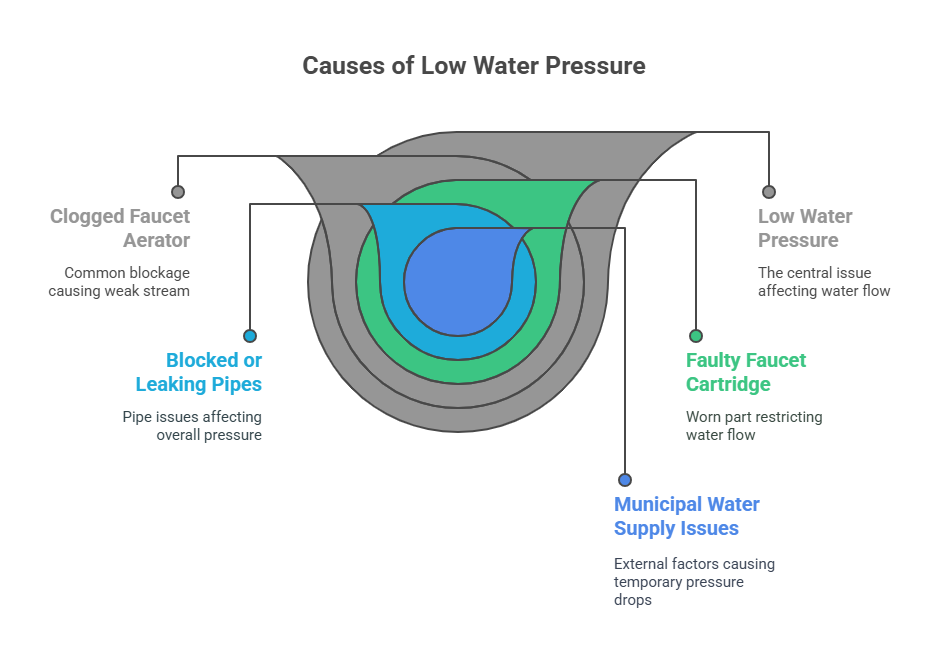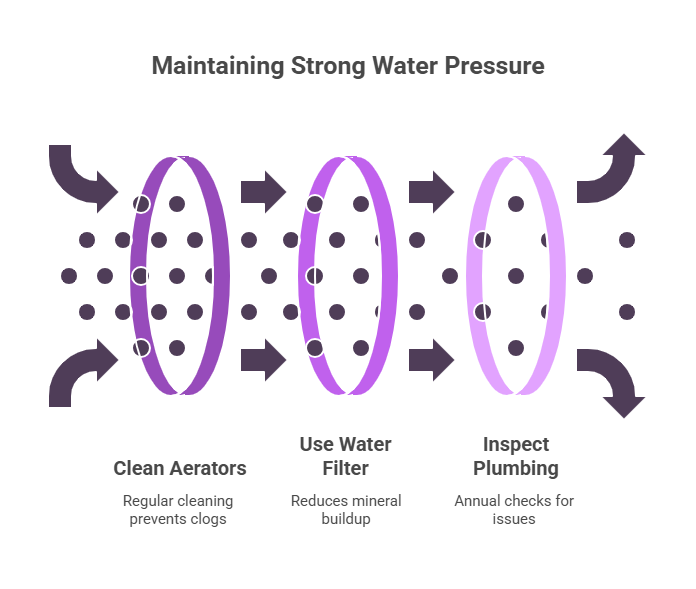If the water pressure is low in your kitchen sink, start by checking the faucet aerator for clogs. Clean or replace it, ensure the shut-off valve is fully open, and test water flow. Most issues are easy to fix with basic tools.
Low water pressure in your kitchen sink can be a daily annoyance. Filling pots takes forever, rinsing dishes feels weak, and even washing hands turns into a chore. If you’ve turned the handle fully but the water still trickles out, you’re not alone—this is one of the most common plumbing problems people face at home.
Luckily, most causes are simple and can be fixed without calling a plumber. Whether it’s a clogged aerator, a shut-off valve that’s not all the way open, or something else, you can usually get things flowing again with a few easy steps. Let’s walk through the common causes, quick fixes, and when it’s time to bring in a pro.
Common Causes of Low Water Pressure in the Kitchen Sink

Clogged Faucet Aerator
The most common reason for low water pressure is a clogged aerator. The aerator is the small screen at the tip of your faucet. Over time, it can collect sediment, rust, or hard water deposits. This blocks the water flow and causes a weak stream.
To check it, unscrew the aerator from the faucet tip. If it looks dirty or has buildup, soak it in vinegar for 30 minutes. Then scrub it with a toothbrush and rinse.
Faulty Faucet Cartridge
Inside most modern faucets is a cartridge that controls water flow and temperature. When this part gets worn out or clogged, it can restrict water pressure.
Signs of a faulty cartridge include:
- Uneven flow between hot and cold
- Weak pressure even with clean aerators
- Dripping or leaking handles
Replacing a faucet cartridge is often easier than people think. You’ll just need a screwdriver and a matching replacement part.
Shut-Off Valve Not Fully Open
Under your sink, you’ll find shut-off valves for both hot and cold water lines. Sometimes these valves aren’t fully open, especially if they were recently adjusted during repairs or installation.
To check this, turn the valve counterclockwise until it stops. Do this for both hot and cold water lines. A partially closed valve can cause slow water flow in one or both settings.
Blocked or Leaking Pipes
If your kitchen sink is the only place with low pressure, it’s likely a local issue. But if several faucets have the same problem, your pipes might be blocked or leaking.
Common signs of this include:
- Water stains or puddles under the sink
- Mold or musty smells
- Drop in pressure across the house
In older homes, pipe corrosion can narrow water flow. This issue may need a plumber to check using inspection tools.
Water Pressure Regulator Problems
Some homes have a water pressure regulator attached where the main water line enters the house. If this regulator goes bad or needs adjustment, it can affect pressure throughout the home—including your kitchen.
To test this, you’ll need a water pressure gauge. You can attach it to an outdoor spigot and compare readings to the standard range of 40–60 PSI. If your reading is low, the regulator may be the issue.
Check out Bob Vila’s guide to water pressure regulators for more help.
Municipal Water Supply Issues
Sometimes, the problem isn’t in your home at all. City water maintenance, construction, or seasonal demands can lower pressure temporarily.
You can call your local water provider or check their website for alerts. If the issue is outside your home, there’s usually nothing you need to fix. It should return to normal soon.
How to Fix Low Water Pressure in a Kitchen Sink (DIY Troubleshooting Guide)

Before you call a plumber, try these simple fixes. Most take less than 30 minutes and need only basic tools.
Tool Checklist
Here’s a quick list of what you may need:
| Tool or Supply | Use Case |
|---|---|
| Adjustable Wrench | Removing faucet parts |
| White Vinegar | Soaking and cleaning aerators |
| Toothbrush | Scrubbing parts |
| Screwdriver Set | Removing faucet handles |
| Plumber’s Tape | Sealing threads |
| Bucket or Bowl | Catching water during disassembly |
| Flashlight | Seeing under the sink |
Step-by-Step: Cleaning the Faucet Aerator
- Unscrew the aerator by hand or with pliers (use a cloth to avoid scratches).
- Soak it in white vinegar for 30 minutes.
- Scrub off any buildup using a toothbrush.
- Rinse and reattach the aerator.
- Turn on the faucet and test water flow.
This fix works in most cases and takes under 10 minutes.
Replacing the Cartridge
- Shut off water under the sink.
- Remove the faucet handle with a screwdriver.
- Take out the cartridge using pliers.
- Buy an exact match from a hardware store.
- Insert the new cartridge, reassemble the faucet, and turn on the water.
A faulty cartridge is a common cause of weak water pressure. If unsure, take the old cartridge to the store to get the right one.
Flushing the Water Line
Sometimes sediment gets stuck in the water lines.
- Remove the aerator.
- Turn the faucet on full blast for 30 seconds.
- Let the water flush any particles from the pipe.
- Reattach the aerator and check pressure.
This works best if you’ve recently had plumbing work done.
Checking for Pipe Leaks or Blockages
Use a flashlight to check for drips or wet areas under the sink. Look for rust, green stains, or mold—these are signs of a slow leak. If pipes look old or blocked, you may need to call a pro.
Adjusting or Replacing the Pressure Regulator
If your water pressure is low everywhere in the house, it might be the regulator. These are often located near the main water shut-off.
Adjustments require a wrench and care—turn the screw clockwise to increase pressure. If the regulator is faulty, replacing it might be your only option. It’s a good idea to hire a plumber for this job if you’re unsure.
When to Call a Plumber
DIY fixes work for many cases. But some problems need expert help. Here’s how to know when it’s time to bring in a plumber:
Signs You Need a Pro
- You’ve tried cleaning the aerator and cartridge, but pressure is still low.
- Pipes are leaking or corroded.
- Pressure is low in the entire house.
- The water pressure regulator is broken.
- You don’t have the tools or confidence to fix it.
Cost Comparison Table
| Fix Type | DIY Cost (Approx.) | Plumber Cost (Approx.) |
|---|---|---|
| Clean Aerator | $0–$5 | $50–$100 |
| Replace Faucet Cartridge | $15–$30 | $100–$200 |
| Pipe Leak Repair (Small) | $0–$25 | $150–$400 |
| Replace Pressure Regulator | $50–$100 | $250–$500 |
Hiring a plumber can save time and prevent future damage. It’s worth the cost if you’re unsure or the problem keeps coming back.
How to Prevent Low Water Pressure in the Future

Taking a few simple steps can help you avoid weak water flow in the future. These easy habits will keep your plumbing working and your kitchen sink pressure strong.
Regular Aerator Cleaning Schedule
Sediment and hard water buildup are the biggest causes of clogged aerators. Cleaning yours every 1–2 months keeps the water flowing freely.
Here’s how:
- Unscrew the aerator
- Soak in vinegar for 20–30 minutes
- Scrub with a toothbrush
- Rinse and reattach
Use a Water Filter to Avoid Sediment Buildup
Hard water is full of minerals like calcium and magnesium. These stick to your faucet and pipes, slowing water flow over time. Installing a faucet filter or whole-house water softener can prevent buildup and make cleaning easier.
You can learn more about hard water and filtering systems from NSF International.
Annual Plumbing Inspection Tips
Once a year, take 15–20 minutes to inspect your kitchen plumbing. Check for leaks, rust, corrosion, or mold under the sink. Make sure shut-off valves turn easily and nothing smells musty.
If you’re not sure what to look for, a local plumber can do a full inspection. It’s a good idea if your home is more than 10 years old or if you’ve had pressure problems before.
Quick Checklist for Troubleshooting Low Water Pressure
This fast checklist helps you spot and fix low kitchen sink pressure without stress. Start at the top and work down until your water flows right again.
| Step | What to Look For | What to Do |
|---|---|---|
| Check faucet aerator | Dirty or clogged screen | Remove and clean with vinegar |
| Check shut-off valves | Partially closed valves | Turn them fully open |
| Test other faucets | Low pressure in more than one place | Could be a whole-house or regulator issue |
| Inspect cartridge | Uneven or weak pressure | Remove and replace cartridge |
| Flush lines | Sediment in pipes | Run faucet without aerator for 30–60 seconds |
| Check for pipe leaks | Wet cabinet, mold, rust | Repair pipe or call a plumber |
| Check water pressure gauge | Low PSI reading | Adjust or replace pressure regulator |
| Call your water supplier | No home plumbing issue found | Ask about citywide problems or maintenance |
Keep this list handy for future reference or save it to your phone for quick use during repairs.
FAQs — Answering Common Questions About Kitchen Sink Water Pressure
What is the fastest way to increase water pressure in the kitchen sink?
Start by removing and cleaning the faucet aerator. It’s often clogged with mineral deposits. Soaking it in vinegar for 30 minutes and scrubbing it can make a big difference. This is the easiest and fastest fix for most people.
Can a clogged pipe cause low pressure in just one sink?
Yes. A clog near the kitchen faucet can reduce water flow only in that sink. It might be in the pipe or in the faucet parts like the cartridge or aerator. If other sinks are fine, it’s usually a local issue.
How do I know if my water pressure regulator is broken?
If you have low pressure in every faucet, the pressure regulator could be the problem. You can test your home’s water pressure with a simple gauge. If it reads below 40 PSI, the regulator may need adjusting or replacing.
Is low water pressure always a sign of a plumbing issue?
Not always. Sometimes it’s a city water supply problem or planned maintenance. You can check with your local utility. If they haven’t reported anything, the issue is likely in your home’s plumbing system.
Conclusion
Low water pressure in your kitchen sink is frustrating, but it’s usually easy to fix. In most cases, a clogged aerator, a stuck shut-off valve, or a dirty cartridge is to blame. These are quick repairs you can do yourself with just a few basic tools.
By following the steps in this guide, you can get your water flowing again without spending money on a plumber. You also now know how to prevent future problems by cleaning your faucet parts and checking your plumbing once a year.
But if none of the fixes work—or if the pressure is low in your whole home—it’s smart to call a professional. They can check your pressure regulator, inspect your pipes, and make sure everything’s safe.
Got a similar issue or tried one of these tips? Share your experience or question in the comments below. You might help someone else—or get the extra tip you need.